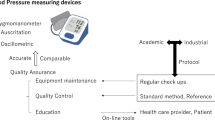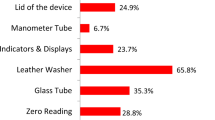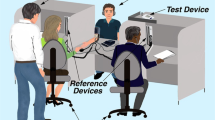Abstract
Unknown to its hypertension specialists, a major teaching hospital changed the cuffs on its sphygmomanometers from manufacturer-validated to a uniform washable alternative, in line with ‘Health and Safety’ concerns surrounding potential cross-contamination between patients. When clinic doctors suspected serious under-reading with the new cuffs, a systematic comparison was undertaken in 54 patients (mean±s.d. age, 61±17 years), using two UM-101 sphygmomanometers, one using the original, manufacturer-supplied cuff and the other with the washable replacement. The study confirmed an average under-reading of 8±10/5±5 mm Hg using the washable cuff, and a third of patients with poorly controlled hypertension were considered normotensive, after using this cuff. The UM-101 sphygmomanometers have now been re-fitted with the original cuffs. Sphygmomanometer cuffs are not interchangeable between devices and a modicum of common sense should be shown to prevent changes made in the name of Health and Safety from having the opposite effect to that intended.
This is a preview of subscription content, access via your institution
Access options
Subscribe to this journal
Receive 12 digital issues and online access to articles
$119.00 per year
only $9.92 per issue
Buy this article
- Purchase on Springer Link
- Instant access to full article PDF
Prices may be subject to local taxes which are calculated during checkout

Similar content being viewed by others
References
Pickering T . The case for a hybrid sphygmomanometer. Blood Press Monit 2001; 6 (4): 177–179.
Stergiou GS, Giovas PP, Gkinos CP, Tzamouranis DG . Validation of the A&D UM-101 professional hybrid device for office blood pressure measurement according to the International Protocol. Blood Press Monit 2008; 13 (1): 37–42.
Baruah J, Kumar S, Gratix A, Dibb W, Madeo M . Blood pressure cuffs as a potential fomite for transmission of pathogenic micro-organisms: a prospective study in a university teaching hospital. J Infect Prev 2008; 9: 19–21.
Brown MJ, Cruickshank JK, Macdonald TM . Navigating the shoals in hypertension: discovery and guidance. BMJ 2012; 344: d8218.
Williams B, Poulter NR, Brown MJ, Davis M, McInnes GT, Potter JF et al. British Hypertension Society guidelines for hypertension management 2004 (BHS-IV): summary. BMJ 2004; 328 (7440): 634–640.
O’Brien E, Petrie J, Littler W, de Swiet M, Padfield PL, Altman DG et al. An outline of the revised British Hypertension Society protocol for the evaluation of blood pressure measuring devices. J Hypertens 1993; 11 (6): 677–679.
Falaschetti E, Chaudhury M, Mindell J, Poulter N . Continued improvement in hypertension management in England: results from the health survey for England 2006. Hypertension 2009; 53 (3): 480–486.
Lewington S, Clarke R, Qizilbash N, Peto R, Collins R . Age-specific relevance of usual blood pressure to vascular mortality: a meta-analysis of individual data for one million adults in 61 prospective studies. Lancet 2002; 360 (9349): 1903–1913.
Bakx C, Oerlemans G, van den Hoogen H, van Weel C, Thien T . The influence of cuff size on blood pressure measurement. J Hum Hypertens 1997; 11 (7): 439–445.
Bellamy JE, Pugh H, Sanders DJ . The trouble with blood pressure cuffs. BMJ 2008; 337: a431.
Acknowledgements
We thank the patients who kindly agreed to assist in the study and research staff within the Clinical Pharmacology Unit for their help. The PATHWAY trials are a multi-centre collaboration among principal investigators of the British Hypertension Society, and are funded by the British Heart Foundation and Comprehensive Local Research Networks. Dr Ian Wilkinson is a British Heart Foundation Senior Clinical Fellow. This work was supported, in part, by the NIHR Cambridge Biomedical Research Centre.
Author information
Authors and Affiliations
Corresponding author
Ethics declarations
Competing interests
The authors declare no conflict of interest.
Rights and permissions
About this article
Cite this article
Shaw, K., McEniery, C., Wilkinson, I. et al. Unsafe health and safety: sphygmomanometer cuffs are not interchangeable. J Hum Hypertens 27, 434–436 (2013). https://doi.org/10.1038/jhh.2012.51
Received:
Revised:
Accepted:
Published:
Issue Date:
DOI: https://doi.org/10.1038/jhh.2012.51



